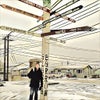Biserica Neagră or Black Church (German: Schwarze Kirche; Romanian: Biserica Neagră; Hungarian: Fekete templom) is a cathedral in Braşov, a city in south-eastern Transylvania, Romania. It was built by the German community of the city and stands as the main Gothic style monument in the country, as well as being the largest and one of the most important Lutheran (Evangelical Church of Augustan Confession in Romania) places of worship in the region.
The originally-Roman Catholic structure was known as the Church of Saint Mary, replacing an older building used for the same purpose. Construction on it began during the late 14th century, at an unknown date — analysis of related evidence has led several researchers to conclude that work began between 1383 and 1385, employing Bulgarian workers and craftsmen who proceeded to establish the Braşov Bulgarian colony in Şcheii Braşovului. According to popular legend, a German child was disturbing the Bulgarian builders or told them that one of the walls was leaning. An annoyed Bulgarian pushed the child off the church tower and then immured his corpse in the church to conceal his crime.
It is known that, in its first stages, the building was serviced by a priest named Thomas (died 1410), whose grave is located in the choir area. Work on the fortifications in the surrounding area probably began at the same time as work on the church, leading in time to the completion of Braşov's third citadel.
Its altar originally featured a single column, but its role in supporting the entire central structure — on the model of German cathedrals built by Hans Stettheimer (a view expressed by researchers such as Ernst Kühlbrandt and Antal Hekler) is under dispute. The naves took longer to complete, and construction was interrupted for various intervals: in 1423, Pope Martin V issued an indulgence for people involved in construction, as a means to reactivate the site; in 1474, a document issued by Sixtus IV acknowledged that work was still lagging.
Several octagonal pillars, redesigned at least once during the building process, were probably completed around 1444. One of them features the inlaid crest of military leader John Hunyadi, who is mentioned among the church benefactors. The most intense work took place before and after 1450, and involved completing the exceptionally large number of portals, including the northern "Golden Gate" and its adjacent altar of the Holy Sacrifice. The eastern portal, commissioned by the Hungarian King Matthias Corvinus, was completed in 1476. The vestry was enlarged at some point between 1500 and 1515.
Completed during the 15th century (soon after 1476), the church belongs to the final stages of Gothic architecture. The result was a three-nave basilica, all the same height, as was preferred during the 15th and 16th centuries in the German lands, where most of the architects and masons originated. Many parts of the building show similarities with the church in Sebeş and St. Michael Church of Cluj-Napoca, as well as with the Dominikánsky kostol in Košice. The design was itself an inspiration for other religious buildings in the region, and it is possible that a stonemason originally employed on the site later worked on the church in Ghimbav.
The Catholic services were replaced with Lutheran ones during the Protestant Reformation, coinciding with the influence exercised by Johannes Honter. A statue in memory of Honter was later erected by Harro Magnussen on one side of the building. The structure was partially destroyed during a great fire set by invading Habsburg forces on the April 21, 1689 (during the Great Turkish War). Afterwards, it became known as the Black Church. A large part of the inner structure was modified during the 18th century, breaking with the original design.
Following the fire of 1689, Biserica Neagră was repaired with the help of masons coming from Danzig, as local craftsmen had not master the craft of completing the enormous vaults; these were to be completed in Baroque style.
Biserica Neagră is 89 meters in length and 38 meters wide. It measures 65 meters from the floor level to the highest point of its only bell tower. The Black Church has a six ton bell, the biggest in Romania, an impressive 4,000 pipe organ built in 1839 by Carl August Buchholz (1796-1884) which is played during weekly concerts, as well as a rich collection of Anatolian carpets (donated in the Middle Ages by Transylvanian Saxon merchants).
Much of the outside structure was built in friable grit, which caused outer sculptures and masonry elements to deteriorate with time. The oldest features surviving include several sculptures, arches, simpler masonry patterns such as trilobes, as well as numerous portals, while the crowning is imitation Gothic dating from the 18th century.
The oldest sculpture appears to be the almost completely deteriorated bust of John the Baptist, located in the choir section, reflects the Bohemian Gothic art as seen in the works of Johann and Peter Parler. A more flamboyant Gothic style was used in the outside sculptures — those probably depicting Biserica Neagră's supposed founder, Thomas, and the Catholic patron saint of Transylvania, Nicholas. Other pieces in that style include the Nativity, Salvator Mundi, an archangel, as well as depictions of saints believed to be the Four Evangelists (probably completed in various stages between 1430 and 1450). Newer medieval sculptures, created after 1450 and showing some Renaissance influences, feature the northward bas-relief depicting Jesus Christ in the Second Temple of Jerusalem, as well as various figures on the same facade. The statue of Mary and Jesus features the coat of arms of Braşov beneath and stands towards the old mayory building, as she is the patron of the city.
A partly destroyed mural, which appears to have been completed around 1477, is situated near the southeastern portal, and features the crests of Matthias Corvinus and his wife Beatrice. It shows the Nativity, together with depictions of Saint Catherine and Saint Barbara. Unlike the inner Annunciation mural, which is late Gothic, the outside painting is heavily influenced by the Renaissance. Biserica Neagră also features a cast iron tabernacle in Gothic style, a baptismal font (completed in 1472 and donated by a merchant named Johannes Rewdel), two large chalices (both dated around 1504) and several brocade chasubles (created between in the late 15th and mid-16th centuries).
The cathedral is a major symbol of Braşov, and a museum open to visitors of the city center. A Lutheran service is held each Sunday for the small German community in the city.





